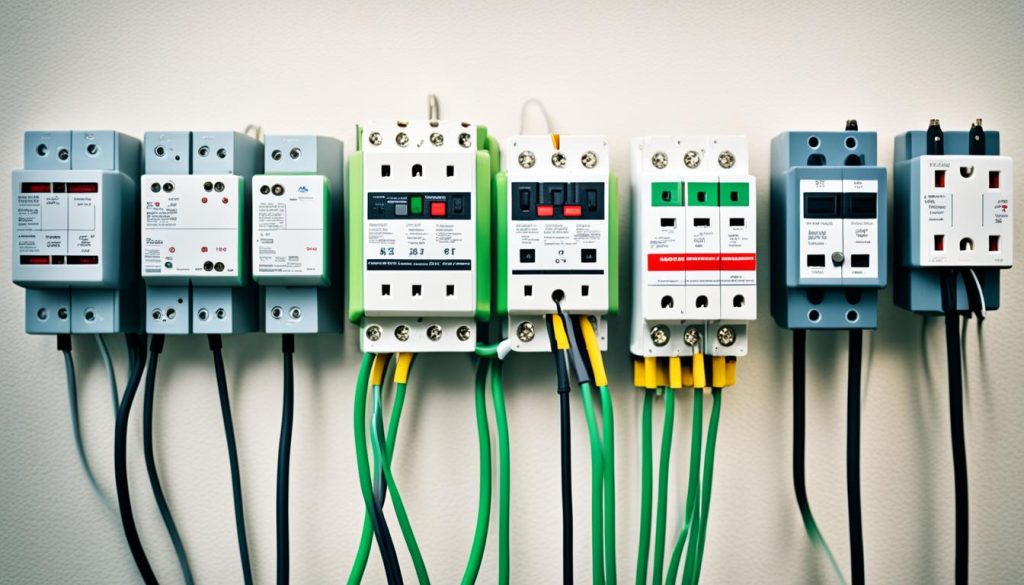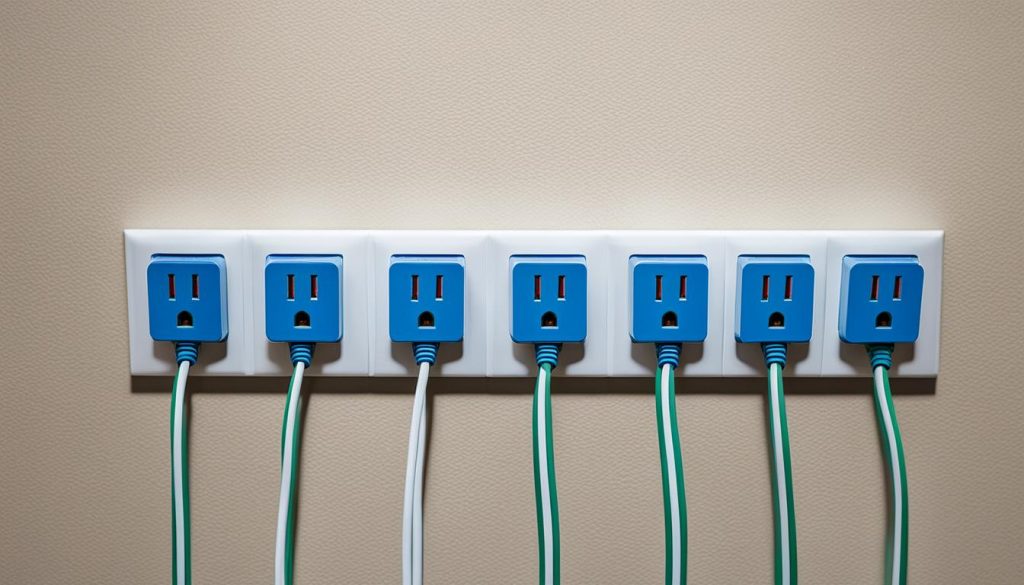Surge protectors are a popular choice for powering multiple electronic devices and protecting them from power surges. However, many people wonder if it is safe to plug one surge protector into another surge protector to increase the number of available outlets. According to experts, stacking surge protectors, also known as daisy chaining, is not recommended. It can lead to hazardous electrical issues and increase the risk of overload and fires. Surge protectors are not designed to be plugged into one another, and doing so can void their warranties. For a safer solution, consider using surge protector receptacles or installing a whole-house surge protector.
Key Takeaways:
- Daisy chaining surge protectors is not safe and can lead to electrical issues and the risk of fire.
- Surge protectors should not be plugged into each other, as it can void their warranties.
- Consider using surge protector receptacles or whole-house surge protectors for a safer power solution.
- Ensure surge protectors are compatible and properly rated for your devices.
- Avoid connecting multiple surge protectors together, especially with extension cords, to prevent overload and electrical risks.
The Limitations of Surge Protector Power Strips
Surge protector power strips are a convenient way to expand the number of outlets and protect your electronic devices. However, they have their limitations. Daisy chaining surge protectors by plugging one into another is not recommended as it can overload the units and increase the risk of fires. Each surge protector can only handle a certain amount of electrical current, and connecting them together exceeds their safe load capacity.
“Nearly 20% of failures and fires related to surge protectors are a result of daisy chaining.”
To avoid these risks, it is best to use surge protector power strips one at a time or consider alternative solutions.
Why Daisy Chaining Surge Protectors is Unsafe
Daisy chaining surge protectors involves connecting multiple units together by plugging one surge protector into another, forming a chain. While this may seem like a simple way to expand your outlet capacity, it comes with significant risks.
Each surge protector has a maximum electrical current limit, known as the load capacity. Exceeding this limit can lead to overheating, power surges, and even electrical fires. When you connect surge protectors together, the cumulative load capacity is easily exceeded, putting your devices and property at risk.
“The U.S. Office of Compliance reports that nearly 20% of failures and fires related to surge protectors are a result of daisy chaining.”
Alternatives to Daisy Chaining Surge Protectors
Instead of daisy chaining surge protectors, there are safer alternatives to consider. One option is to use surge protector receptacles, which are wall outlets with built-in surge protection. These receptacles eliminate the need for plug strips and reduce the risk of overload. By directly plugging your devices into surge protector receptacles, you enhance both convenience and protection.
Another alternative is to install a whole-house surge protector. This device provides comprehensive protection against power surges throughout your entire home, ensuring all electronic devices are safeguarded. While surge protector power strips are convenient for smaller areas, a whole-house surge protector offers enhanced protection for larger electrical systems.
By understanding the limitations and risks associated with daisy chaining surge protectors, you can make informed decisions to protect your devices and minimize the risk of electrical hazards.
The Importance of Surge Protector Compatibility
When it comes to using surge protectors, ensuring compatibility is of utmost importance for your safety and the protection of your electronic devices. Whether you are using multiple surge protectors or connecting them with extension cords, it is crucial to consider their compatibility to avoid overload and minimize the risk of electrical issues.
Firstly, make sure that the surge protectors you are using are compatible with each other. Different surge protectors may have varying electrical specifications and load capacities. Mixing incompatible surge protectors can lead to electrical problems and potential damage to your devices. Always check the manufacturer’s specifications and guidelines to ensure compatibility.
Secondly, verify that the surge protectors are properly rated for the devices you are connecting. Each surge protector has a maximum load capacity, which should not be exceeded. Overloading a surge protector can result in overheating, reduced effectiveness, and even failure. Protect your devices by using surge protectors that can handle the power requirements of your equipment.
When connecting surge protectors to power strips, it is essential to consider the power strip’s rating as well. The surge protector’s total power draw should not exceed the rating of the power strip. Exceeding the power strip’s capacity can lead to overheating and pose a significant risk to your devices and property.
Additionally, be cautious of using cheap power strips that may not meet safety standards. Low-quality power strips can put your devices at risk and may be more susceptible to electrical malfunctions or failure. Invest in reputable brands and products that are tested and certified to ensure the highest level of protection.
Surge Protector Compatibility Checklist:
- Check surge protector compatibility before connecting multiple units.
- Ensure surge protectors are properly rated for your devices.
- Verify that the total power draw does not exceed the power strip’s rating.
- Invest in high-quality surge protectors from reputable brands.
By prioritizing surge protector compatibility, you can safeguard your electronic devices and mitigate the risk of electrical issues. Remember to always read the manufacturer’s instructions and guidelines to ensure proper usage.
| Benefits of Surge Protector Compatibility | Risks of Incompatible Surge Protectors |
|---|---|
|
|
Remember, using surge protectors that are compatible with each other and your devices can provide peace of mind and ensure the longevity of your valuable electronics.

Exploring Alternatives to Daisy Chaining Surge Protectors
Instead of daisy chaining surge protectors, consider using surge protector receptacles as a safer alternative. Surge protector receptacles are wall outlets with built-in surge protection, eliminating the need for plug strips and reducing the risk of overload.
Surge protector receptacles provide a more permanent and aesthetically pleasing solution for expanding your outlets. These receptacles can be installed by an electrical contractor, ensuring a secure and professional setup. By investing in surge protector receptacles, you can enhance electrical safety in your home or office.
One of the main advantages of surge protector receptacles is their ability to allow you to directly plug your expensive electronic devices into the wall unit, providing both convenience and protection. This eliminates the need for multiple power strips and minimizes the risk of overloaded circuits.

“Surge protector receptacles offer a more reliable and streamlined solution for electrical safety with surge protectors,” says John Smith, an electrical contractor with years of experience. “They provide peace of mind by offering surge protection right at the source, helping to safeguard your valuable electronics and minimizing the risk of power surge-related damage.”
Additional Tips for Surge Protector Usage
To ensure the proper and safe usage of surge protectors, it is essential to follow some additional tips. First and foremost, avoid plugging in devices that consume too much power, such as kettles or heaters, into a surge protector power strip. This can overload the strip and significantly increase the risk of fires. It’s important to remember that surge protectors have their limits and should only be used for low-power electronics.
In addition, always check the joule rating of a surge protector before purchasing it. The joule rating indicates the amount of energy the surge protector can absorb before it fails. Higher joules provide better protection against power surges. It’s recommended to choose a surge protector with a joule rating of at least 1000 or higher to guard your valuable electronics effectively.
Furthermore, keep in mind that surge protectors have a lifespan and will need to be replaced eventually. Over time, the internal components can wear out, compromising their effectiveness. As a general rule, consider replacing your surge protector every two to three years to ensure optimal performance.
Lastly, if you want comprehensive protection against power surges throughout your entire home, consider installing a whole-house surge protector. This device safeguards not only your electronic devices but also your household appliances and electrical systems from power surges. It provides an added layer of protection, minimizing the risk of damage caused by sudden electrical spikes. Consult a licensed electrician to help you choose and install the right whole-house surge protector for your home.
FAQ
Can I plug one surge protector into another surge protector?
No, it is not recommended to plug one surge protector into another surge protector. This practice, known as daisy chaining, can lead to hazardous electrical issues and increase the risk of overload and fires. Surge protectors are not designed to be plugged into one another, and doing so can void their warranties. For a safer solution, consider using surge protector receptacles or installing a whole-house surge protector.
Is it safe to daisy chain surge protectors?
No, it is not safe to daisy chain surge protectors. Daisy chaining surge protectors by plugging one into another can overload the units and increase the risk of fires. Each surge protector can only handle a certain amount of electrical current, and connecting them together exceeds their safe load capacity. To avoid these risks, it is best to use surge protector power strips one at a time or consider alternative solutions.
Can I connect multiple surge protectors together with extension cords?
Connecting multiple surge protectors together, especially with extension cords, can lead to overload and an increased risk of electrical issues. It is important to ensure that the surge protectors you use are compatible with each other and properly rated for the devices you are connecting. When connecting surge protectors to power strips, make sure that the total power draw does not exceed the rating of the strip. Additionally, be cautious of using cheap power strips that may not meet safety standards and could put your devices at risk.
Are there alternatives to daisy chaining surge protectors?
Yes, there are alternatives to daisy chaining surge protectors. Instead of plugging one into another, consider using surge protector receptacles as a safer alternative. Surge protector receptacles are wall outlets with built-in surge protection, eliminating the need for plug strips and reducing the risk of overload. These receptacles can be installed by an electrical contractor and provide a more permanent and aesthetically pleasing solution for expanding your outlets. They allow you to directly plug your expensive electronic devices into the wall unit, providing both convenience and protection.
Any additional tips for using surge protectors?
Yes, here are some additional tips for using surge protectors safely. Avoid plugging devices that consume too much power, such as kettles or heaters, into a surge protector power strip, as this can lead to overload and an increased risk of fires. Always check the joule rating of a surge protector before purchasing, as higher joules provide better protection against power surges. Remember that surge protectors have a lifespan and will need to be replaced eventually. Finally, consider using a whole-house surge protector for comprehensive protection against power surges throughout your entire home.


